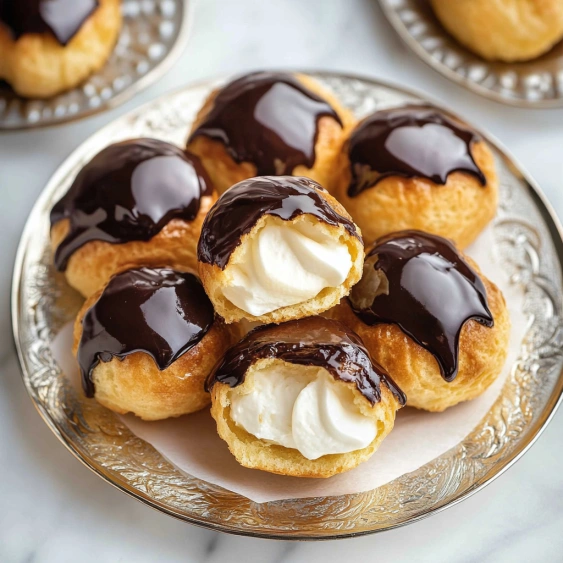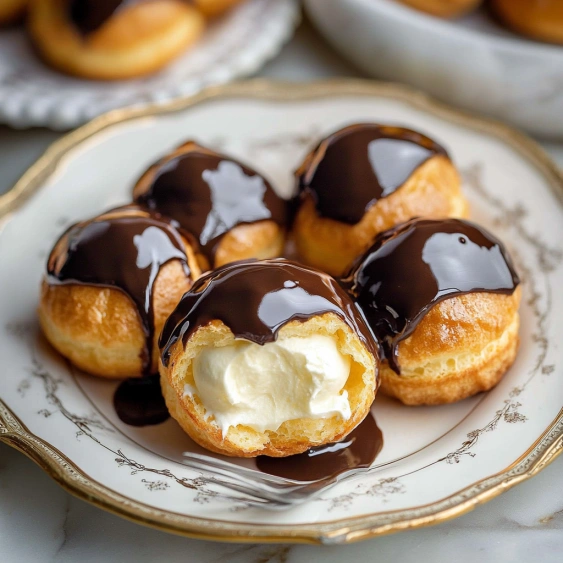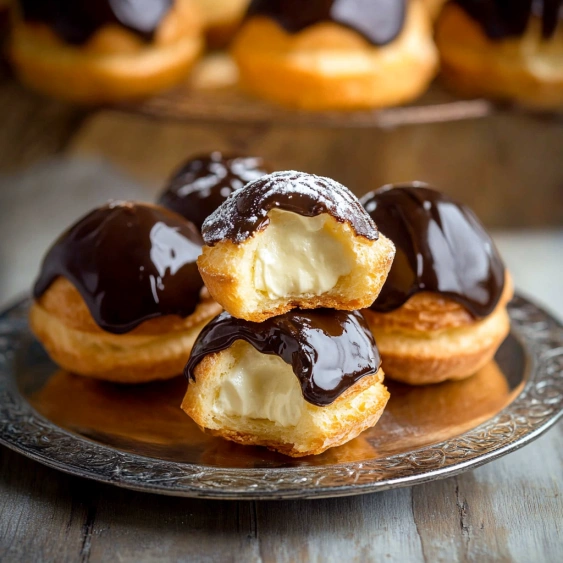 Pin it
Pin it
This classic French profiterole recipe creates delicate pastry shells filled with creamy vanilla custard and topped with glossy chocolate ganache. The crisp exterior gives way to a luscious filling for a dessert that balances textures and flavors perfectly—an impressive treat that's worth the effort for special occasions.
I first learned to make these in culinary school and have been perfecting my technique for years. The moment when my daughter bit into her first homemade profiterole and her eyes widened with pure joy made all the careful steps worthwhile.
Ingredients
For the profiteroles
- Unsalted European style butter: 82% fat content ensures proper moisture and richness in the choux pastry
- Water and whole milk: Combination provides the perfect moisture balance for light and airy puffs
- Bread flour: High protein content gives structure to help the pastries rise properly
- Room temperature eggs: Create an emulsion that traps steam during baking for maximum puff
For the pastry cream
- Whole milk: Creates a luxuriously smooth base for the custard filling
- Egg yolks: Provide richness and help thicken the cream naturally
- Cornstarch and flour: Work together for the ideal silky yet stable texture
- Vanilla extract: Adds warmth and depth to the filling flavor profile
For the chocolate ganache
- High quality semisweet chocolate: Like Callebaut or Lindt makes a significant difference in flavor
- Heavy cream: 36% fat creates the perfect glossy consistency
- Room temperature butter: Adds shine and prevents the ganache from setting too firmly
Step-by-Step Instructions
- Prepare the choux pastry:
- Begin by sifting the flour to remove any lumps. Combine butter, water, milk, salt, and sugar in a saucepan over medium heat until it reaches a simmer without boiling. This gentle heating ensures the fat properly emulsifies with the liquid ingredients.
- Create the panade:
- Remove from heat and add all the flour at once, stirring vigorously with a rubber spatula until completely smooth. Return to heat and cook for 3 to 5 minutes while constantly stirring. You know it is ready when a thin skin forms on the pan bottom and some liquid has evaporated. This crucial step removes excess moisture for proper rising.
- Incorporate the eggs:
- Transfer the dough to a stand mixer with paddle attachment and mix on low for about a minute to cool slightly. Gradually add the whisked eggs in small amounts, allowing full incorporation between additions. The perfect consistency is reached when the dough falls from the paddle in a V shape without being runny. This usually takes 2 to 3 minutes of mixing.
- Pipe and rest:
- Transfer dough to a pastry bag with a 0.5 inch French star nozzle and refrigerate for one hour. This resting period relaxes the gluten and improves the final texture. Pipe 16 evenly sized mounds onto a perforated baking mat or parchment lined sheet, holding the bag at a 90° angle with consistent pressure. Smooth any pointed tips with a wet fingertip and dust lightly with powdered sugar to prevent cracking. Freeze for at least one hour.
- Bake to perfection:
- Preheat oven to 200°C then place frozen profiteroles inside. Immediately reduce temperature to 170°C and bake for 30 minutes without opening the oven door for the first 20 minutes. The shells should be golden, puffed, and maintain their shape at room temperature.
- Prepare the pastry cream:
- Whisk sugar and egg yolks until fluffy, then incorporate cornstarch, flour, and vanilla. Heat milk until simmering, then gradually pour into the egg mixture while whisking constantly to prevent curdling. Return to the saucepan and cook over medium heat, stirring continuously until thickened. Add softened butter in chunks until fully incorporated, then cool completely with plastic wrap directly on the surface.
- Make the chocolate ganache:
- Semi melt chocolate in the microwave while heating cream to a simmer. Pour hot cream over chocolate and stir until smooth, then add butter for shine. Allow to cool to 30°C for the perfect dipping consistency that sets with a gorgeous sheen.
- Fill and glaze:
- Create a small hole in the bottom of each cooled profiterole and fill with pastry cream using a piping bag. Dip the tops in chocolate ganache, tapping gently to remove excess. Chill briefly to set the glaze before serving.
 Pin it
Pin it
My secret ingredient is the high quality European butter. I discovered its importance after a disastrous attempt with regular butter left my profiteroles flat and greasy. The higher fat content and lower water percentage makes all the difference in achieving that perfect hollow center.
Storage Tips
The unfilled profiterole shells can be stored in an airtight container at room temperature for up to 2 days or frozen for up to a month. To revive slightly softened shells, place them in a 300°F oven for 5 minutes to crisp up again before filling. The pastry cream can be refrigerated for up to 3 days with plastic wrap pressed directly onto the surface to prevent skin formation. Assembled profiteroles will soften quickly, so they are best enjoyed immediately after preparation.
Troubleshooting Common Issues
If your profiteroles deflate after baking, the most likely culprit is underbaking. The shells need to be thoroughly dried out in the oven to maintain their structure. Opening the oven door too early can also cause collapse due to the sudden temperature change. If your choux pastry is too runny, you may have added too much egg or not cooked the panade long enough to remove sufficient moisture. Add a little more flour to correct the consistency before piping.
Serving Suggestions
For an elegant dessert presentation, arrange 3 to 4 profiteroles in a small pyramid on individual dessert plates. Drizzle with additional warm chocolate ganache and garnish with fresh berries, mint leaves, or a light dusting of powdered sugar. For a dramatic dinner party finale, create a traditional croquembouche by stacking profiteroles into a cone shape and binding them with caramel threads. Serve with champagne or a dessert wine like Sauternes for a truly special occasion.
The History Behind Profiteroles
Profiteroles originated in Renaissance Italy before being perfected by French pastry chefs in the 1500s. The name comes from the French word "profit," meaning a small gain or benefit. Originally served as a savory dish filled with cheese or meat, they evolved into the sweet dessert we know today during the 18th century. The classic choux pastry technique used for profiteroles forms the foundation for many other French pastries including éclairs, Paris Brest, and gougères.
 Pin it
Pin it
Frequently Asked Questions
- → Why does my choux pastry collapse after baking?
Collapsing profiteroles typically result from underbaking or opening the oven door too early. Ensure you bake for the full 30 minutes at 170°C/338°F without opening the oven for at least 20 minutes. The pastry needs to develop a firm structure and dry out properly to maintain its shape. Another common cause is insufficient moisture evaporation during the stovetop cooking stage before adding eggs.
- → Can I make profiteroles in advance?
Yes! The components can be prepared separately in advance. Baked unfilled shells can be stored in an airtight container for 1-2 days or frozen for up to a month. The pastry cream can be refrigerated for up to 3 days. For best results, fill and glaze profiteroles shortly before serving to maintain the contrast between crisp shell and creamy filling.
- → How do I know if my choux pastry has the right consistency?
Perfect choux dough should fall from the paddle attachment in a V-shape and hold its form. It should be glossy and pipeable but not runny. If it's too stiff, add a small amount of beaten egg. If too runny, cook it slightly longer to evaporate more moisture. The dough should be firm enough to pipe cleanly while maintaining defined shapes.
- → Why freeze the piped dough before baking?
Freezing the piped profiteroles for at least an hour before baking serves multiple purposes. It helps the dough maintain its shape during baking, prevents spreading, and promotes even rising. The frozen exterior gives the pastry time to set in the oven before expanding, resulting in taller, more uniform puffs with better hollow centers for filling.
- → What's the best way to fill profiteroles?
The most effective method is creating a small hole in the bottom of each profiterole using a skewer or piping tip. Then use a piping bag with a small round tip to fill them with pastry cream. Fill until you feel resistance, which indicates the profiterole is full. Alternatively, you can cut them in half horizontally and spoon the filling into the bottom half before replacing the top.
- → How do I get a glossy finish on my chocolate ganache?
For a perfect glossy finish, ensure your ganache is at the correct temperature (around 30°C/86°F) before dipping. After dipping, chill the profiteroles briefly for 2-3 minutes to set the ganache without condensation forming. Using high-quality chocolate with proper cocoa butter content and adding butter to your ganache also contributes to the shine and smooth texture.
